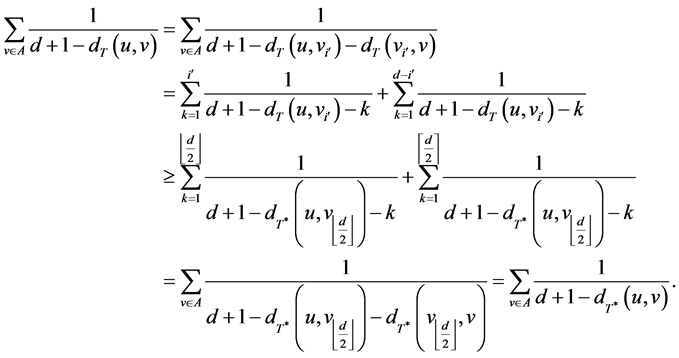Applied Mathematics
Vol.07 No.03(2016), Article ID:63916,8 pages
10.4236/am.2016.73020
Reciprocal Complementary Wiener Numbers of Non-Caterpillars
Yanli Zhu, Fuyi Wei, Feng Li
Department of Applied Mathematics, South China Agricultural University, Guangzhou, China

Copyright © 2016 by authors and Scientific Research Publishing Inc.
This work is licensed under the Creative Commons Attribution International License (CC BY).
http://creativecommons.org/licenses/by/4.0/



Received 14 January 2016; accepted 23 February 2016; published 26 February 2016
ABSTRACT
The reciprocal complementary Wiener number of a connected graph G is defined as

where  is the vertex set.
is the vertex set.  is the distance between vertices u and v, and d is the diameter of G. A tree is known as a caterpillar if the removal of all pendant vertices makes it as a path. Otherwise, it is called a non-caterpillar. Among all n-vertex non-cater- pillars with given diameter d, we obtain the unique tree with minimum reciprocal complementary Wiener number, where
is the distance between vertices u and v, and d is the diameter of G. A tree is known as a caterpillar if the removal of all pendant vertices makes it as a path. Otherwise, it is called a non-caterpillar. Among all n-vertex non-cater- pillars with given diameter d, we obtain the unique tree with minimum reciprocal complementary Wiener number, where . We also determine the n-vertex non-cat- erpillars with the smallest, the second smallest and the third smallest reciprocal complementary Wiener numbers.
. We also determine the n-vertex non-cat- erpillars with the smallest, the second smallest and the third smallest reciprocal complementary Wiener numbers.
Keywords:
Reciprocal Complementary Wiener Number, Wiener Number, Caterpillar

1. Introduction
The Wiener number was one of the oldest topological indices, which was introduced by Harry Wiener in 1947. About the recent reviews on matrices and topological indices related to Wiener number, refer to [1] - [4] . The RCW number is one of the hotest additions in the family of such descriptors. The notion of RCW number was first put forward by Ivanciuc and its applications were discussed in [5] - [8] .
Let G be a simple connected graph with vertex set . For two vertices
. For two vertices , let
, let  denote the distance between u and v in G. Then, the RCW number of G is defined by
denote the distance between u and v in G. Then, the RCW number of G is defined by

where d is the diameter and the summation goes over all unordered pairs of distinct vertices of G. Some properties of the RCW number have been obtained in [9] [10] .
A tree is called a caterpillar if the removal of all pendant vertices makes it as a path. Otherwise, it is called a non-caterpillar.
For integers n and d satisfying , let
, let  be the tree obtained from the path
be the tree obtained from the path  labelled as
labelled as
 by attaching the path
by attaching the path  and
and  pendant vertices to vertex
pendant vertices to vertex  for
for 
In this paper, we show that among all n-vertex non-caterpillars with given diameter d, 

2. RCW Numbers of Non-Caterpillars
All n-vertex trees with diameter 2, 3, 





the class of non-caterpillars obtained by attaching the stars 
pendant vertices to one center (fixed if it is bicentral) of the path







Let T be a tree. For 



sum of all distances from u to the vertices in A, i.e.,

Lemma 1 Let T be a tree with minimum RCW number in


Proof. Suppose that 

we require that

Case 1. One of 


outside 









Figure 1. The tree Nn,d,i.
Figure 2. The tree NC (n,d).
all



with equality if and only if





Then
with equality if and only if 





since 



Case 2. Any verter 











Let 








This is a contradiction.
By combining Cases 1 and 2, we find that 
Lemma 2 Let 

with equality if and only if
Proof. Let T be a tree with the minimum RCW number in

Suppose that there is a vertex 







obtained from T by deleting edges 








and then

Suppose that there are at least two vertices of T outside 
with 








This is a contradiction. Thus there is exactly one vertex outside 


By a direct calculation, we get
Combining Lemmas 1 and 2, we get
Theorem 1 Let

with equality if and only if
Lemma 3 For

Proof. If d is even, then
If d is odd, then
The result follows.
Theorem 2 For
And 


Proof. Let




and hence 

Now suppose that
where equality holds if and only if 
Case 1. n is odd. Let 

Case 2. n is even. Let 
Thus, the proof is finished.
Cite this paper
YanliZhu,FuyiWei,FengLi, (2016) Reciprocal Complementary Wiener Numbers of Non-Caterpillars. Applied Mathematics,07,219-226. doi: 10.4236/am.2016.73020
References
- 1. Ivanciuc, O. (2003) Graph Theory in Chemistry. In: Gasteiger, J., Ed., Handbook of Chemoinformatics, Wiley-VCH. Weinheim, 103-138.
http://dx.doi.org/10.1002/9783527618279.ch6 - 2. Ivanciuc, O. (2003) Topological Indices. In: Gasteiger, J., Ed., Handbook of Chemoinformatics, Wiley-VCH, Weinheim, 981-1003.
http://dx.doi.org/10.1002/9783527618279.ch36 - 3. Janezic, D., Milicevic, A., Nikolic, S. and Trinajstic, N. (2007) Graph-Theoretical Matrices in Chemistry. University of Kragujevac, Kragujevac.
- 4. Luo, W. and Zhou, B. (2009) On Ordinary and Reverse Wiener Indices of Non-Caterpillars. Mathematical and Computer Modelling, 50, 188-193.
http://dx.doi.org/10.1016/j.mcm.2009.02.010 - 5. Ivanciuc, O. (2000) QSAR Comparative Study of Wiener Descriptors for Weighted Molecular Graphs. Journal of Chemical Information and Modeling, 40, 1412-1422.
http://dx.doi.org/10.1021/ci000068y - 6. Ivanciuc, O., Ivanciuc, T. and Balaban, A.T. (2000) The Complementary Distance Matrix, a New Molecular Graph Metric. ACH-Models in Chemistry, 137, 57-82.
- 7. Ivanciuc, O., Ivanciuc, T. and Balaban, A.T. (2002) Quantitative Structure-Property Relationship Evaluation of Structural Descriptors Derived from the Distance and Reverse Wiener Matrices. Internet Electron. Journal of Computer-Aided Molecular Design, 1, 467-487.
- 8. Ivanciuc, O., Ivanciuc, T. and Balaban, A.T. (1999) Vertex- and Edge-Weighted Molecular Graphs and Derived Structural Descriptors. In: Devillers, J. and Balaban, A.T., Eds., Topological Indices and Related Descriptors in QSAR and QSPR, Gordon and Breach, Amsterdam, 169-220.
- 9. Cai, X. and Zhou, B. (2009) Reciprocal Complementary Wiener Numbers of Trees, Unicyclic Graphs and Bicyclic Graphs. Discrete Applied Mathematics, 157, 3046-3054.
http://dx.doi.org/10.1016/j.dam.2009.05.001 - 10. Zhou, B., Cai, X. and Trinajstic, N. (2009) On Reciprocal Complementary Wiener Number. Discrete Applied Mathematics, 157, 1628-1633.
http://dx.doi.org/10.1016/j.dam.2008.09.010


























